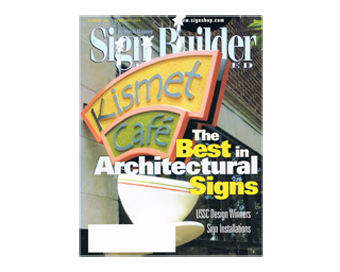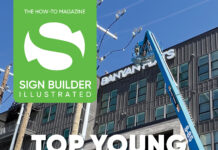 When asked to write this article about how sign codes and sign regulations have evolved over the last twenty-five years, I had to do some math to figure out the year. 1987! That date seems like ancient history, and in today’s fast-moving world, it probably is.
When asked to write this article about how sign codes and sign regulations have evolved over the last twenty-five years, I had to do some math to figure out the year. 1987! That date seems like ancient history, and in today’s fast-moving world, it probably is.
I started by going to my own newsletter archives. My initial thought was, “All I have to do is look up what we were writing about in 1987.”
But like all things that look easy on the surface, it turned out to be more difficult than anticipated. I began to realize that, although there have been huge changes in the industry over the past twenty-five years, many things have remained constant. The French have a saying for it: “Plus ça change; plus c’est la même chose.” English translation: “The more things change, the more they stay the same.”
The Year 1987
+ In 1987, we were fighting anti-sign zoning bans on internal illumination. Today we are still fighting those battles. In 1987, we were working with numerous towns in the region re-writing their ordinances. Today, with the help of the USSC Model Code, we are still working on re-writing ordinances.
+ Twenty-five years ago, towns wanted to ban neon. Today they still want to ban neon, but they’ve added LEDs and EMCs, etc. to the list.
+ In 1987, the new product on the market was “electric awning signs.” Were they awnings and part of the architecture, or were they signs that required a permit?
+ Twenty-five years ago, there was a new brochure produced by the National Lighting Bureau regarding outdoor lighting and its ability to improve security. Today we are still trying to prove that lighting from signs at night keeps an area more secure and limits crime.
+ In 1987, there was concern about flashers and chasers and other things that “move” or “change” on a sign. Today we are dealing with dwell times and lighting levels.
+ Twenty-five years ago, the word “electronic” was just starting to be used in conjunction with “changeable message signs.”
+ In 1987, the American Planning Association (APA) was the enemy. Today we have a cordial dialogue with the APA, exhibit at their annual convention, and distribute our research and Model Code to its members.
+ Twenty-five years ago, Times Square was starting to be redeveloped and they wanted to revitalize in part with “brighter lights and fancier signs.”
+ In 1987, there was no Internet (except on a few college campuses)—no e-mail, downloading, uploading, or Web pages. Today the Internet has changed the way we all do business. Except twenty-five years ago, you had to personally visit each town where you needed to get a permit and although today you can access many forms via the Internet, a sign company still has to file those forms in person at a majority of the municipalities.
+ Twenty-five years ago, there was no ADA, Dark Sky Society, wide format printers, digital signage, etc. But most importantly, in 1987, there was no USSC as we know it today.
What did exist at that time was our predecessor organization, the Eastern States Sign Council. ESSC was an all-volunteer organization comprised of eight separate state sign associations in the Northeast Region of the country. The volunteers from each association ran a successful convention and education program, every year changing the location and host state. In 1987, the New York State Sign Association was hosting the ESSC convention and education program in Buffalo, New York.
What were the most common problems in 1987? You guessed it—sign codes and sign regulations.
 How The Industry Has Changed
How The Industry Has Changed
The most noticeable industry change over the past twenty-five years is active participation in local sign organizations. As I read through these pieces of our history, the one thing that was apparent in every single issue was the participation on the part of the membership.
Monthly dinner meetings regularly attracted 75 to 100 people. There were annual picnics and dinner dances and golf outings and often a sign company would open up their shop for a meeting and invite competitors to come into their facility. They were willing to share ideas, tips, techniques, and the inevitable complaints. The comaraderie among the sign company owners was amazing.
This “friends with your competitor” attitude was the primary reason why the ESSC was so successful. As they worked together and talked, the leaders of each state organization realized that they were fighting some common problems throughout the region, and that they would be more successful in fighting them together as a common unit than individually.
By 1992, ESSC formed a much stronger unit through membership—it now represented a larger group and this was often very important when fighting codes and regulations that would affect the entire industry. We not only had to deal with thousands of municipalities but also governmental and quasi-governmental entities such as EPA, OSHA, SBA, BOCA, UL, NEC, NFPA, and more.
By 1995, ESSC had evolved into the United States Sign Council (USSC) with nationwide membership. We now had an even larger platform from which we could speak. One of the initial goals of USSC was to represent sign companies in the zoning and regulatory arenas.
The Year 2012
The areas of sign industry involvement are largely the same today as they were then; we’re still working to bring a better economic climate to towns across the country through better signage.
And although the name of the association has changed, its mission has not. It is still the organization that fights legislative and regulatory battles on a daily basis and serves its membership through communication and education.
People change, names change, technology changes—but it takes a long time to change the minds of those who have set ideas.
Slowly we’re seeing it happen. The recent recession has made towns, planners, and government agencies ask us how they can promote a better economic climate through better signage.
That’s a huge change. And even though we’re still fighting battles on a regular basis, it’s nice to occasionally get a request for assistance from a town that wants to allow signs that will enhance the ability of its merchants to do business and create a thriving economy.
Here I can unequivocally say that the most important change in the last twenty-five years has been the arsenal of research the USSC has amassed since the mid-90s. With fourteen research studies, the USSC Standards, and the USSC Model Code, we can now base our recommendations on more than just our own experiences.
We have solid scientific evidence for proper lighting levels, letter size, sign height, and more. And it’s working!
 The Year 2037
The Year 2037
Signs have been around since the first merchant hung out a shingle with a hand drawn picture. And I am relatively sure signs will continue to be around for centuries to come because they are a vital part of every community.
So how will signs and technology evolve twenty-five years from now? In 2037, will the codes and regulations be based entirely on scientific research? What about the new technologies? And will we finally be able to get permits and variances via the Internet (or whatever replaces the Internet)?
I wish I had these answers, but there’s one thing I know for sure: Plus ça change; plus c’est la même chose!
—Nancy Maren
Nancy Maren is executive director of the United States Sign Council.











